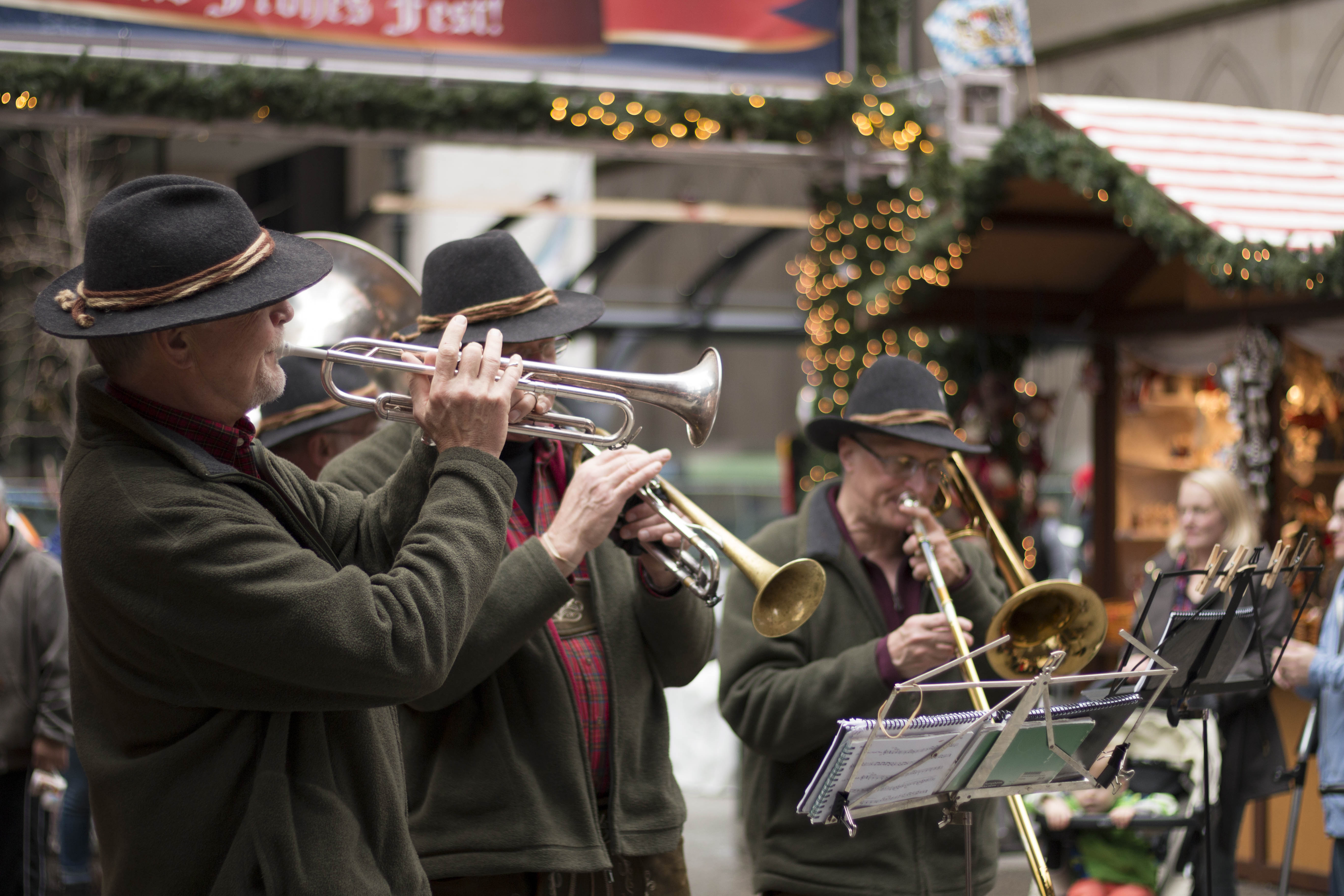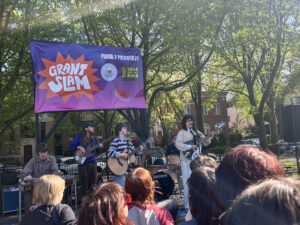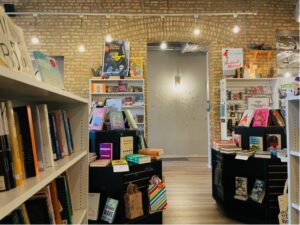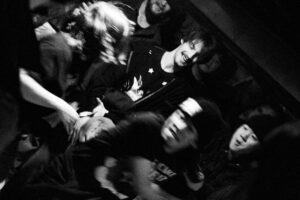Retired schoolteacher Ruth Hosek enjoyed her sumptuous potato pancakes at a small stand-up table in the center of a maze of unique gift shops, candy huts. All around were lines of people speaking many different languages but laughing in the same joyous tune.
In a time of constant change when technology is always raising the entertainment bar and new versions of products are available every few months, the Christkindlmarket in Daley Plaza remains unperturbed, holding out its warm arms to give guests a friendly, free, comfortable and familiar Christmas-time welcome.
This year the Christkindlmarket is home to 55 vendors, carrying a variety of items from handmade crafts to culinary delicacies. Many come straight from Germany for the opportunity to sell their wares in the American marketplace. After all, the motivation behind starting the market 20 years ago was trade between Germany and the United States.
The fresh smells of glühwein (hot, spiced wine), sausage, crêpes, heaps of chocolate and the charming aesthetics of the red and white huts adorned with Christmas lights remain unchanged at the Christkindlmarket.
Hosek visited Christmas markets when she taught school in Germany, and said Chicago’s version is very similar.
“The little huts are pretty much exactly the same, so I have to say I think they did a pretty good job recreating it as well as they could,”  Hosek said.
Hosek said.
Ringing in its 20th year in the Windy City, the Christkindlmarket prides itself on its consistency.
“We try to be consistent with our layout; we try to be consistent with the type of vendors we offer, which is a high-end and unique offering” said Maren Biester Priebe, vice president and managing director of Christkindlmarket Chicago.
Everyone from the elderly to toddlers with their parents flock to the Sweet Swabian hut to choose from assorted flavored nuts, including rum pecans and Irish cream almonds. Also available are heart-shaped gingerbread cookies with German or American sayings written in frosting.
Christina Colon, 29, has worked at Sweet Swabian for the past four years. She believes consistency is important. She said many customers know what they want, so it is important for the product to stay the same every year.
“You can’t get it anywhere else,” Colon said. “I have people who come and they buy bags and bags of [nuts] just for this year.”
It’s not just sweets that keep people coming back to the market every year.
“For families it is a place to come to enjoy the holidays,” Priebe said.
“For business folk, it is a great place to meet up with potential clients or business partners, have lunch or dinner. For the general public I think it’s a place where they can meet up with friends, families, acquaintances.”
The Christkindlmarket’s stability has not always been met with open arms.
Debbie West, 60, has been coming to the market for about 10 years.
“The market itself has stayed the same, but the crowds every year get bigger and bigger,” West said.
She added she doesn’t particularly like how crowded the market has become. “Most of the younger people I think come here to drink,” West joked.
But the sign of a growing crowd could be the sign of a tradition expanding.
One customary item that draws people to the market is the souvenir mug. The design of the mug changes every year, but its concept stays the same — something you can take home and remember the year, market, and German Christmas customs forever by.
“We design them every year to make sure they are different, unique, you know, definitely a nice souvenir item,” Priebe said.
The mug has almost always been boot-shaped, a design many people accustomed to the market have grown to love — a design strayed from last year to some discontent.
For this year’s 20th anniversary, the Christkindlmarket brought back its signature boot-shaped mug, much to the customer’s delight.
“Every year as the market evolves, they sort of see what does really well and they stick with that, and they like to try new things, too,” said Eric Pedersen, 30, who works at Bavarian Tradition.
“The consumers’ tastes change as the trends come and go throughout the years, that kind of dictates what [vendors] carry as well.”
The market works closely with the German vendors.
“We consult with them as well to tell them sort of what works here in the United States that may not work in Germany or vice versa — everything from labeling, to content, to how they do their marketing and things like that.” Priebe said.
Miriah Barry, 24, works at Straub Artglas, a popular booth where one can get hand-etched glass. She said the market really helps with organization and helping set up connections, business or otherwise.
The market is great at “organizing everything so that it functions as a whole rather than independently,” Barry said. “That’s the thing about German culture, they’re always helping one another. It’s making sure everyone comes out on two feet and is ready to go for the market.”
Antje Walter, 52, has been worki ng at the market for 16 years at Glaszauber Lauscha. She sells handmade, intricately designed and painted glass ornaments. As a small family business owner in Lauscha, Germany, Walter enjoys being able to come to Chicago to sell the products her business works to make all year. In 2014, Walter’s company expanded to the United States.
ng at the market for 16 years at Glaszauber Lauscha. She sells handmade, intricately designed and painted glass ornaments. As a small family business owner in Lauscha, Germany, Walter enjoys being able to come to Chicago to sell the products her business works to make all year. In 2014, Walter’s company expanded to the United States.
Steiff, a company known for its well-made teddy bears and stuffed animals, has gained a large following in the American marketplace since it started showcasing at the Christkindlmarket.
Brianna Lasseter, 23, a new market employee, said she was very excited to work the Chicago staple and even more excited to be at the Steiff booth.
“Steiff has been around since 1880,” Lasseter said. “In Germany, whenever your kid was born or you wanted to give a gift, you would give one of the stuffed animals; it’s like a keepsake for life.”
“A lot of people collect Steiff, and they’re really well made.”
Lasseter said many people have come up to her saying how glad they were to see Steiff and telling stories of how their parents gave them the stuffed animals when they were little.
The market offers many traditions for its customers: from purchasing items at certain vendors each year, to tasting traditional German cuisine, to the designated Kinder Tag (kid’s day) that includes a lantern parade and other kid-friendly activities.
Despite younger and larger crowds, not much can stop the infectious Christmas-time custom that is the Christkindlmarket (especially when it includes stuffing ones face with roasted nuts and snowmen shaped cookies, pointing out the cutest nutcrackers, and listening to live Christmas music.)
Barry understands the tradition of the market and knows it reaches people from all different walks of life.
“I think most people who come here are descendants of people, immigrants from Germany, so it allows them to reconnect with their family culture,” Barry said. “I would say the remaining people appreciate handmade  things, and that’s kind of key. When people can window shop and you know meet the maker of something, it truly adds value.”
things, and that’s kind of key. When people can window shop and you know meet the maker of something, it truly adds value.”
There is no doubt the Christkindlmarket Chicago is a one-of-a-kind business move for all of the German vendors, which is perhaps why so many keep coming back year after year.
“The turnaround is very small, it’s very similar to what you find in Germany. Once you have a vendor that participates, there really isn’t one that wants to leave,” Priebe said.
“We like to make sure that our event is as traditional and authentic as possible, and a lot of vendors are part of that contributing factor, and that makes it a little bit more organic. It’s a family here.”

















Be First to Comment